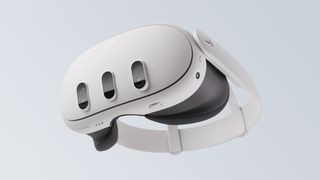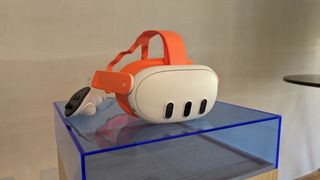Meta Quest 3: price, specs, release date, features, and everything you need to know
Here’s everything there is to know about the Meta Quest 3

The Meta Quest 3 has been officially unveiled at Meta Connect 2023 – Meta’s annual conference for all things metaverse and AI. If want a full rundown of the event you can check out our Meta Connect 2023 recap, or for our more in-depth thoughts on the new headset you can read our hands on Meta Quest 3 review (that’s right we’ve had the chance to try it out already).
The highlights of the new headset are its upgraded Qualcomm Snapdragon XR2 Gen 2 chipset, its improved mixed reality capabilities and its trimmed-down design in terms of the headset and its controllers.
According to Meta, the Quest 3 is its "most powerful headset" yet, beating out both the Meta Quest Pro and the Oculus Quest 2, and we’re inclined to agree. We need to spend more time with the VR gadget but we could see this rocketing to the top of our best VR headsets list once our full review is complete. Let’s get into the Meta Quest 3’s price, specs and other features to explain why that is.
Meta Quest 3: price
The Meta Quest 3 has two models which are identical in every way except storage size. The cheaper of the two has 128GB of storage and costs $499.99 / £479.99 / AU$799.99. Alternatively, you can pick up a Quest 3 model with 512GB of storage for $649.99 / £619.99 / AU$1,049.99.

This is pricier than the Quest 2 was when it launched, though it had less storage at first. Meta sold a 64GB model for $299 / £299 / AU$479. It did later replace this model with a 128GB option at the same price (before upping the price to $399.99 / £399.99 / AU$629.99 and then coming back down to $299.99 / £299.99 / AU$509.99).
Meta Quest 3: release date
The Meta Quest 3 is up for preorder right now and it will release on October 10, 2023. There have been reports of some lucky customers getting their orders early, though they aren’t yet able to activate the headset using the Meta Quest mobile app.
To incentivize you to put in an order soonish, Meta will give everyone who puts in an order for a Meta Quest 3 before January 27 a free copy of Asgard’s Wrath 2. If you decide to go for the more pricey 512GB model you’ll also get a six-month subscription to Meta Quest Plus – a service that gives you new free VR games and apps every month that you can play as long as you’re subscribed.
Get the best Black Friday deals direct to your inbox, plus news, reviews, and more.
Sign up to be the first to know about unmissable Black Friday deals on top tech, plus get all your favorite TechRadar content.
Meta Quest 3: specs
Here are the specs for the Meta Quest 3, and the Oculus Quest 2’s specs to compare them to.
| Header Cell - Column 0 | Meta Quest 3 | Oculus Quest 2 | Meta Quest Pro |
|---|---|---|---|
| Dimensions | 184 x 160 x 98 mm | 192 x 102 x 143 mm | 265 x 127 x 196 mm |
| Weight | 515g | 503g | 722 g |
| Display | Two LCD displays | Single LCD display | Two LCD quantum dot displays |
| Display resolution | 2064 x 2208 pixels per eye | 1832 x 1920 pixels per eye | 1,832 x 1,920 pixels per eye |
| FOV | 110 degrees horizontal, 96 degrees vertical | 89 degrees horizontally, 93 degrees vertically | 106 degrees horizontal, 96 degrees vertical |
| Refresh rate | 72Hz, 80Hz, 90Hz, 120Hz | 72Hz, 80Hz, 90Hz, 120Hz | 72Hz, 80Hz, 90Hz |
| Chipset | Qualcomm Snapdragon XR2 Gen 2 | Qualcomm Snapdragon XR2 Gen 1 | Qualcomm Snapdragon XR2+ Gen 1 |
| RAM | 8GB | 6GB | 12GB |
| Storage | 128GB or 512GB | 128GB or 256GB (64GB discontinued) | 256GB |
| Battery life | 2 hours 12 minutes | 3 hours | 2 hours |
Meta Quest 3: software and features

Games and apps
Every single game and app in the Quest store will be playable on the Meta Quest 3. What’s more, Meta has said that over 50 of them are getting Quest 3 upgrades before the end of 2023 – be it to take advantage of the new and improved specs, or mixed reality support. On top of this over 50 new games and apps will be launching on the Quest store before the end of the year with Quest 3 support (though it's not clear if this means they’ll be exclusive to the new headset, or just be playable on it).
Exclusive software is likely on the way, though with the Quest 2 still so popular we imagine Meta may want developers to support both systems – albeit giving Quest 3 players some worthwhile improvements to their version of the game or app.
Full-color Mixed reality
Mixed reality is a lot better on the Meta Quest 3 than either the Quest 2 or the Meta Quest Pro. For a start it’s full-color, relying on two RGB cameras placed on the headset’s front visor. This footage is a lot brighter, less grainy and more colorful than what the Quest Pro’s single RGB camera could provide.
It also has a new depth sensor which should make it easier for mixed reality software to understand the layout of your room. Virtual objects can know when they hit a wall or another object in the space and react accordingly.
The overall effect is mixed reality that looks and feels much more exciting to be immersed in.

Automatic play space mapping
The Quest 3 can also use its new sensors and its AI to automatically detect the size and shape of your VR play space. Plus, it can warn you when an object comes into this area. This should make it a lot easier to slip on your headset and start playing in VR or MR.
Augments
Augments are new mixed reality widgets you can use to decorate your home. We haven’t had much experience using them, but Meta says they can do a wide range of things. They might be a portal to your favorite game like Asgard’s Warth 2, a floating media player for iHeart Radio, a trophy you won in Beat Saber, or a simple decoration you like the look of.
Bets of all your Quest 3 will remember where you’ve put your augments, so when you return to your playspace in the future everything will be just where you left it.
Meta Quest 3: design
You won’t find the Meta Quest 3 reinvents the wheel when it comes to VR headsets, but it offers a few improvements to its predecessor’s design.

Firstly it’s now 40% slimmer thanks in large part to its pancake lens optical system. This seems to make it more comfy to wear even though it is a little heavier than the Quest 2 at 515g instead of 503g.
It also now has an IPD adjustment wheel that gives you more control over the distance between the lenses. The Quest 2 only gave you three presets and you had to take the headset off to change it. On the Quest 3 the wheel is placed underneath the visor so you can make lens adjustments without taking it off.
Lastly, the Quest 3’s controllers now don’t have tracking rings. These plastic rings found on most VR handsets allow the headset to follow the controllers more easily, but the Quest 3 instead relies on AI and IR LEDs in the controller to track them. This system works surprisingly well from our tests so far, and it means you no longer need to worry about bumping your tracking ring into something while immersed in VR.

Hamish is a Senior Staff Writer for TechRadar and you’ll see his name appearing on articles across nearly every topic on the site from smart home deals to speaker reviews to graphics card news and everything in between. He uses his broad range of knowledge to help explain the latest gadgets and if they’re a must-buy or a fad fueled by hype. Though his specialty is writing about everything going on in the world of virtual reality and augmented reality.
- Henry Stockdale
- Rhys WoodHardware Editor
Most Popular

